by John Byrne Barry | Apr 14, 2020 | End of Life, Home, Uncategorized
An Interview with End-of-Life Consultant Arielle Friedtanzer
Author note: This interview took place before the world changed, so Arielle and her husband are no longer on the road, but staying in southern California with her parents.
 I met Arielle Friedtanzer last November when she attended my book launch in Tam Valley (“Why I Wrote an Assisted Suicide Family Thriller”), one of the more than 200 events comprising Reimagine End of Life, a San Francisco Bay Area wide exploration of big issues about life and death.
I met Arielle Friedtanzer last November when she attended my book launch in Tam Valley (“Why I Wrote an Assisted Suicide Family Thriller”), one of the more than 200 events comprising Reimagine End of Life, a San Francisco Bay Area wide exploration of big issues about life and death.
By last November, Arielle had been on the road for fifteen months, traveling around the country with her husband, engaging individuals and communities in a variety of end-of-life conversations, helping people identify their values and wishes for the end of life, and working to reduce the stigma around aging and death.
Arielle hosted three events as part of Reimagine End of Life SF — “Death With Dignity: A Question with Countless Answers” and two iterations of ”Millennials & Mortality: A Young Adult View on Aging & Death,” one which included dinner and was strictly for millennials.
I spoke with her in late February, before the world changed.
You’ve been travelling around the county and leading conversations about end-of-life issues. How did that come about?
My husband and I moved out of New York in July 2018. We had a bunch of weddings to go to that fall, so we thought we’d take our time and travel to them and in between them. Since I’m exploring end-of-life issues, I reached out to see where I might connect with people who were interested in conversations about death and grief and so on. My husband is a film critic, so he had some film festivals to attend.
We created a road trip out of our destinations, one of which was the Reimagine festival in California. We didn’t have a plan for how long we’d travel or where we’d go, but we’re still on this giant road trip and are loving it!
Where are you now? Where are you headed?
Today, we’re in Florida, driving north to Cape Canaveral, where we’re meeting our parents for a cruise, a big birthday celebration for me and 77 other Leap Day Babies.
Tell me about the kinds of presentations you’re doing.
I’ve done about 30 programs — from preschool to millenials, from young parents to seniors. I am reaching out primarily to Jewish communities, since that’s my closest point of contact as a Jewish woman. I say, I’m coming to the area, are you interested in me leading a conversation about end-of-life issues.
Sometimes they might say we’re interested, but we don’t know about turnout. That never worries me because I think that only the people who are ready to engage in this conversation will show up. It’s not about the numbers, it’s about the conversation that ensues with whoever is in the room. I’ve found that the millennial programs are some of the most successful.
How do you target the millennials? I would think that death is not necessarily something they’re thinking about. That your events would be more likely to attract older people, especially those dealing with aging parents.
Most people assume that millennials don’t want to talk about these issues or don’t have anything valuable to contribute to the conversation. But they do. We do. Many of us have experienced life-altering losses in our families and inner circles, or are caregiving for aging and sick loved ones right now. So I want to make sure that we have a safe space to talk about these issues that reflects our ages and interests and means of connection. We are so often left out of these important conversations and we are often the most eager to have them.
Can you give me a specific example of an event you did recently?
Here’s one from last week. This synagogue in Boca Raton hired me as a scholar-in-residence. They took care of all the publicity. It was called, “Talking to our Children and Grandchildren About Death.”
Turnout was less than we all hoped, but talking about death is not for everyone. I did four events and there were several repeat attendees. Some came to all four. Two came to three of them.
One older person who attended all four programs walked into the first one and asked me how old I was, seemingly questioning my experience in this field. Then she said, “You may have the knowledge, but I have the experience.” That’s one reason I love what I do — I’m changing the face of this conversation and showing people of all ages that this isn’t something only our parents and grandparents talk about.
What did you say?
I said that I’ve been around death a long time. By the time I went to college, I’d been to two dozen funerals. It’s not a matter of age. I take great comfort in funerals.
Why?
Funerals are beautiful opportunities to hear about people who died, to hear about their accomplishments, the silly things they did, all the ways they made a difference in the world.
That reminds me of when a friend of mine died twenty years ago, and I helped organize the memorial and it was so moving hearing all these people tell stories and express such beautiful sentiments. I remember thinking, I don’t want to wait until I’m dead to hear all this. So, for my fiftieth birthday, I asked people to say nice things about me while I was still here to enjoy them.
That’s amazing! Like a living funeral. You don’t have to wait until you die for that. Last week I did a program around mourning and grieving rituals, and another on planning your own funeral. It’s an awesome exercise that I learned from a great Reimagine friend of mine.
So how did you get from being attracted to funerals to leading end-of-life conversations?
Since my bat mitzvah, I wanted to be a rabbi. Then, since I worked as a first-aid responder in Israel, I wanted to be a doctor.
In college, I did a Jewish medical ethics program. During one session, we were meeting with the head of the palliative care unit, and as soon as he described what they did, that’s when I realized this was the work I needed to do with my life.
Now my goal is to be a chaplain, a spiritual caregiver.
I recently completed an individualized Master’s degree at NYU in Judaic Studies, Bioethics, and Social Work, and I did an internship at Memorial Sloan Kettering Cancer Center, where it seemed that patients and family members were more open to talking about death than I had seen elsewhere.
I also recently experienced the deaths of both of my remaining grandparents. My grandmother died, and my grandfather mourned her for the traditional seven days of shiva (Jewish mourning period) and died the night he completed it. I knew that was what he wanted and I could not have designed a better death for him than the one he had.
My belief is that if you have these conversations, you may be able to have the death you want. And even before the moment of death, it is an amazing way to deepen our relationships with the people we feel closest to.
What’s your experience of the end-of-life movement? It seems to have grown in leaps in bounds in the last number of years.
I think it is growing. My mom says death is a hot topic. It’s becoming more of a normal conversation, but I still don’t think it’s something everyone is ready, willing, or excited to talk about. Still, there are great organizations that deserve a lot of credit for that change. Like Reimagine End of Life. Like End Well.
But there’s a long way to go. Last year, I was arranging to do a program at an assisted living facility, and the person I was talking to said, “Well, we don’t really like talking about death.”
Are you kidding? I thought. This is the last home for everyone who lives here, and there’s still this compartmentalism, this denial. So I modified what I did, and learned a lot from what the residents shared with me.
People want to tell their story. I always ask people if they have something they want to share. So many people do, and often, there aren’t the spaces for them to do so.
What I’ve learned in my travels is that everyone has a story about death — personal, professional, good, bad — and they want to share it with someone. But talking about the end of life is not something that can be forced. The people who come to my events are curious, open, grieving. They have to be ready to talk about death, their own or someone else’s, or they won’t show up.
What do people say when you tell them what you do?
Oh, that’s so interesting, they say. I know someone who’s…and they segue into something related to death or dying. Or they say, that’s really morbid and they inch away. Which I always find to be a little funny.
Do you have a regular spiel?
Well, I thought I was just going to help people have these end-of-life conversations, but I’ve had to tailor all sorts of programs to the specific communities. One I’ve now done a few times is how to talk to kids about death. That’s a question I get often, so I built a program around that.
For many of my programs, the goal is to determine what people want their end of life to look like and how we can make that happen. I ask participants what would be most important to them at the end of life using a deck of “wish” cards meant for this very purpose, stressing that it’s what they find to be most important now since we never know when that time will come. Then we explore how to have this conversation with our loved ones at home since they might have to make those choices for us.
Sounds like intense work. Is this sometimes heavy for you?
It can be a heavy responsibility, but I don’t find it to be burdensome. What happens a lot is that there are people unloading grief. It’s so interesting and meaningful, to witness and carry those stories. Mostly I listen. Usually it doesn’t feel heavy. Often it’s the anxiety that is heavy. People are afraid to talk about death, but when they do it, they’re less afraid.
Do you ever feel like you’re over your head?
All the time.
What do you do?
I talk to my husband. I talk to my parents. The imposter syndrome is real. It’s something that I am constantly working on.
A lot of times I’ll prepare a program, and I’ll think, oh nothing in this feels unique or different. It feels just like common sense. But it’s not common sense to everyone. It’s important to give people a space to feel what they’re feeling. They need to be validated. The more programs I do, the more I am reminded that what I have to offer is my willingness to engage in these conversations, and to facilitate the dialogue and hold the space for others. The rest will follow.
How long is your road trip going to continue?
I have no idea. It’s been a year and a half now. When we started, our parents thought we’d be on the road for a year. We had plans to keep the trip going before COVID-19 struck, so right now we’re basing ourselves in L.A. and taking things one day at a time.
by John Byrne Barry | Jan 23, 2017 | Uncategorized
My wife and I had planned on walking together in the Women’s March this past Saturday. But pressing family issues came up on Friday, she had to cancel, so at the last minute, I signed up to be a marshall at the march, a “peace ambassador,” and I arrived at at Madison Park in Oakland early Saturday morning, where I got an orientation and a neon yellow vest.
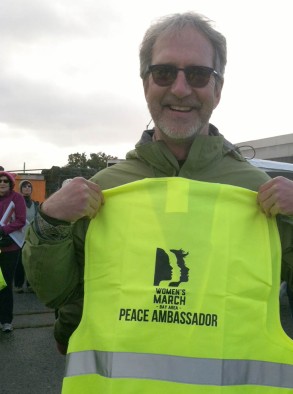
The park was still pretty sleepy at 8 a.m. Elderly Chinese were doing tai chi and badminton volleys on the west side of the park, and on the east side, a dozen or two volunteers were gathering and chatting. The sky was overcast, but there was no rain, and the sun peeked through now and then.
We all teamed up with buddies and one member of each team got a radio, and then we went over the route and various contingency plans. They divided us into groups by where we were standing and I ended up as one of three dozen or so volunteers whose job it was to create a wedge in front of the lead banner, clearing the center of the street for the march and creating enough space in front for photo ops.
This proved to be more complicated than I imagined. By the time we left the park, shortly after 10 a.m., the streets were so packed with people, we had to clear a path before the march could start.
At 9th and Oak Street, about 30 to 40 of us peace ambassadors held hands, formed a V-shaped wedge, and walked north on Oak Street, gently herding people from the center of the street to the sides. We walked about two blocks, trying to hold the space behind us as we moved forward. Then about half of us turned around, and went most of the way back, to where the folks holding the lead banner had set up, across four lanes of Oak Street. A man named Stefan with a megaphone was directing us — it felt like a military operation even though we were marching for peace.
(One fellow marshall noted, that of course, we had to have a man with a megaphone giving orders at the front of a women’s march. But he knew what he was doing, and the vast majority of the marshals in the front and the people behind the lead banner were women.)
Later on Saturday, someone shared a CNN video on Facebook of marches throughout the county, and there I was in the upper left corner of a clip from Oakland. With my fanny pack and bald spot on the top of my head. You can see the space we created in front of the banner.
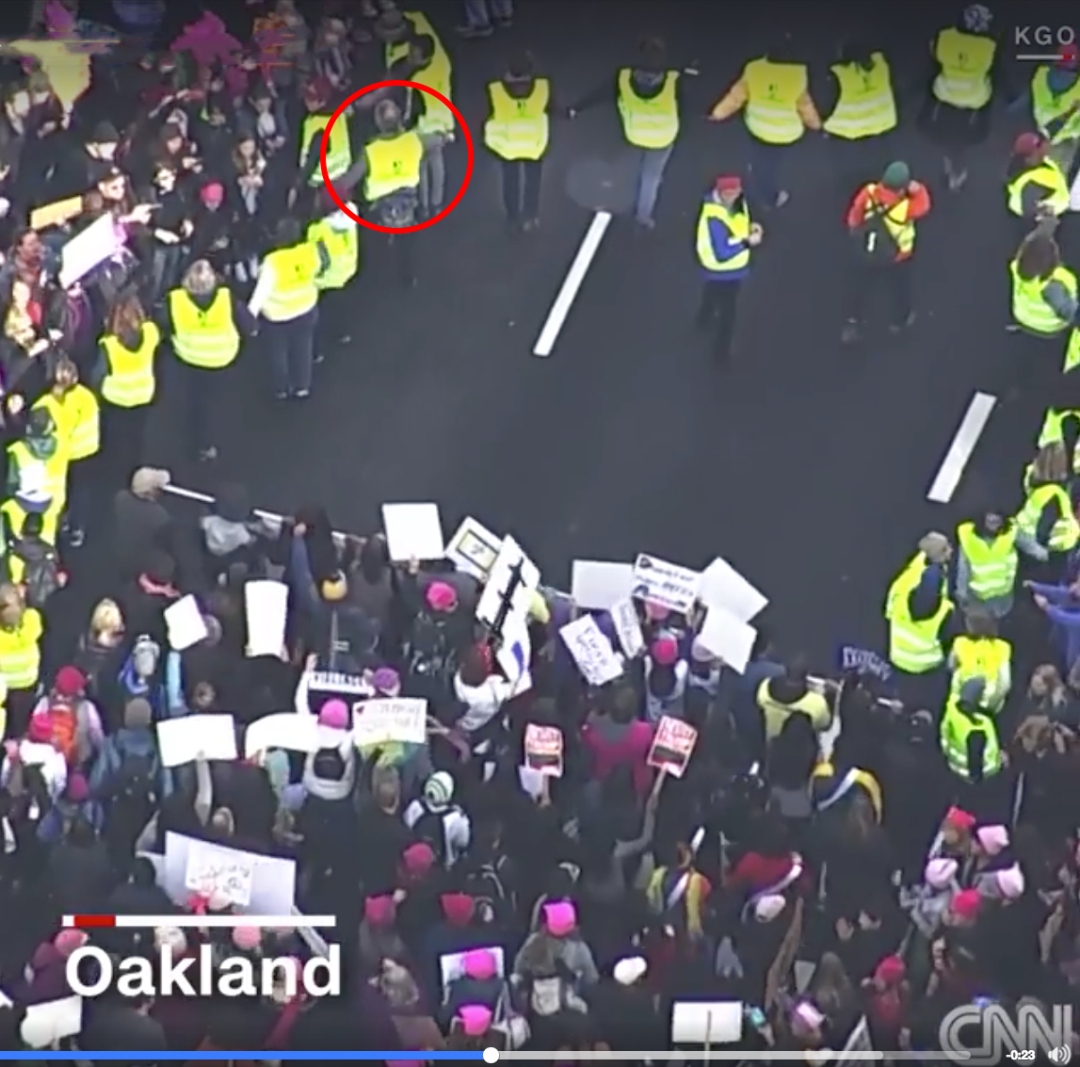
Here it is from further above. See that empty space behind the wedge.
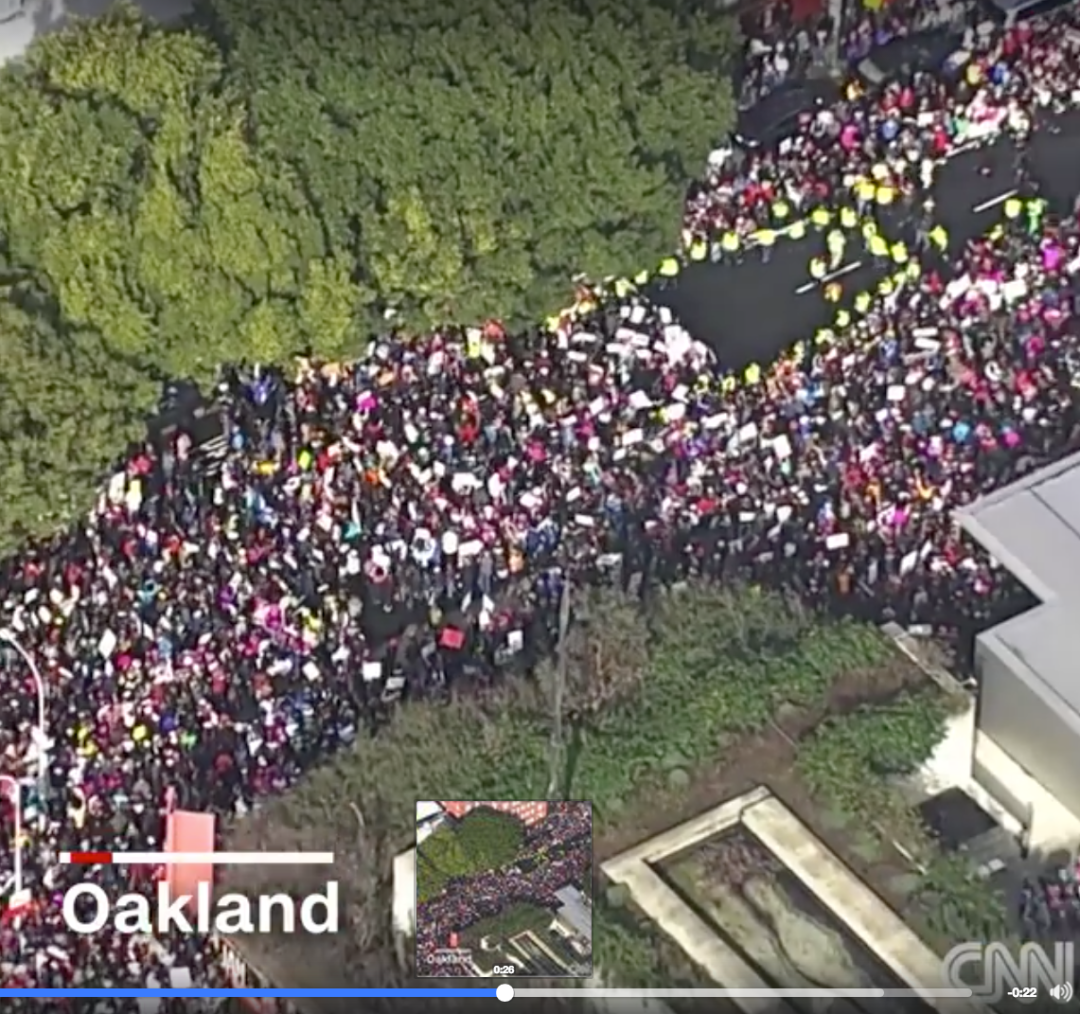
And here’s what the lead banner looked like from the front. (Photo by James Lerager.)
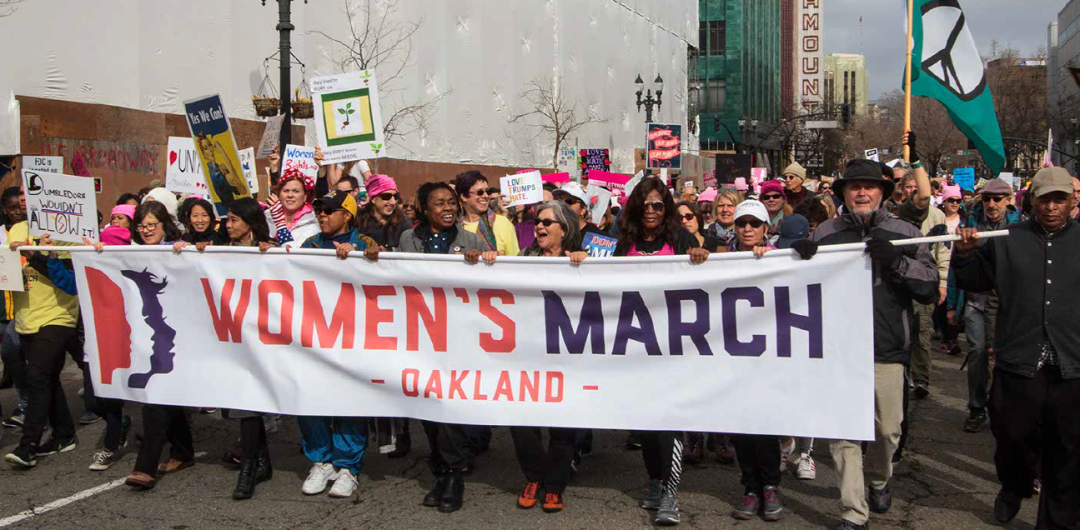
We started marching. We were directed to slow down, speed up, and now and then to stop and kneel, so photographers could get a better photo. “If only,” someone quipped, “someone was documenting this amazing march.” If only.
One of my buddies, Lily, was at the apex of the wedge for most of the march. I shouted over to her at one point, “Hey, Lily, I bet you weren’t expecting you’d be leading the march.” She shook her head and smiled.
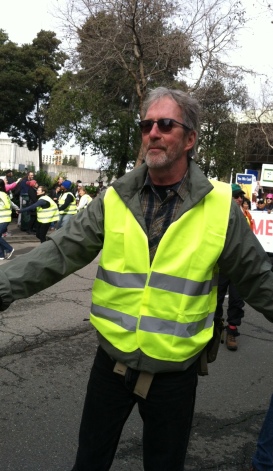 I was on her left, about three or four people away, walking sideways for much of the march, holding hands with Jane, my other buddy, a few feet ahead of me on my right, and a man whose name I never learned a few feet behind me on my left. Sometimes both my arms were being pulled, in opposite directions. We didn’t always stay in formation, but the wedge worked the way it was supposed to. I had never given much thought to how to manage a march. It was harder than I expected, especially with crowds in the tens of thousands. We heard estimates ranging from 60,000 to 100,000. I was in no position to assess the size of the crowd, other than it was larger than organizers expected. And everyone was peaceful.
I was on her left, about three or four people away, walking sideways for much of the march, holding hands with Jane, my other buddy, a few feet ahead of me on my right, and a man whose name I never learned a few feet behind me on my left. Sometimes both my arms were being pulled, in opposite directions. We didn’t always stay in formation, but the wedge worked the way it was supposed to. I had never given much thought to how to manage a march. It was harder than I expected, especially with crowds in the tens of thousands. We heard estimates ranging from 60,000 to 100,000. I was in no position to assess the size of the crowd, other than it was larger than organizers expected. And everyone was peaceful.
The energy, the camaraderie, the creativity, the love was palpable. It felt as much like a celebration as a protest, though of course, the signs were defiant.
Some of my favorites.
“Girls just want to have fun-damental rights.”
“You’re so vain, you probably think this march is about you.”
“The future is female.”
“We are the wall.”
“I would not want to be the guy who pissed all these women off.”
A wonderful day. A wonderful march. I’m so grateful I stumbled into the opportunity to lead it. Sort of.
I’m going to treat this experience as if it’s a metaphor for something. Now I just need to figure out what it is.
Thanks to all the hard-working folks who organized the march. Now we start the really hard work.
—
If you haven’t already gorged on march photos, here are more from the Oakland march, courtesy of James Lerager.
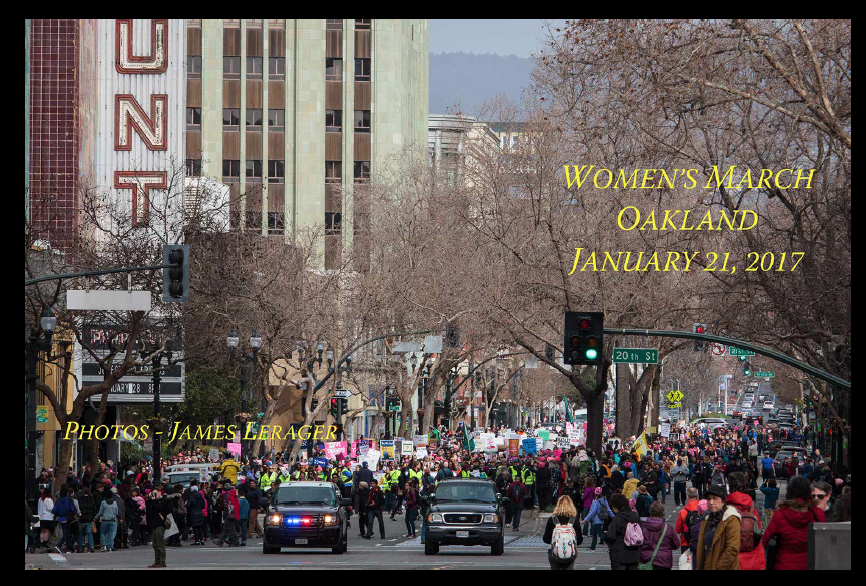
by John Byrne Barry | Jan 28, 2016 | Uncategorized
I’ve written less than half of my third novel, but I have a clear idea of what I’m aiming to do, and I’ve been getting better at my elevator pitch every time I do it.
But until today, I’d never delivered it in a real elevator. I’m more of a climbing-the-stairs person.
Yesterday, at the Mill Valley Library, however, where I’m occasional participant in the library’s twice-weekly writing salon, I was talking with two newcomers, both therapists, as we left the meeting room. One punched the button for the elevator. I had a momentary urge to say goodbye and do my self-righteous thing of taking the stairs. But then he asked me about the novel I’m working on. I said it was about euthanasia. They both seemed interested. The elevator doors opened. We walked in.
“Well, here’s my elevator pitch,” I said, as the doors closed. “Let’s see if I can do it in two floors. The protagonist is a therapist. His father has cancer and dementia and wants his son to help him end his life. The son refuses at first, then agrees, and then his sister accuses him of murder at their father’s memorial. What follows is a high-profile public fight between the death-with-dignity crowd on the one hand and the right-to-lifers on the other, with each sibling the reluctant front person.”
The elevator was slow, so I finished just as the doors opened and let us out in the children’s library. My two elevator-mates each said something positive about my pitch, though I don’t remember the words they used.
“The hard part,” I added, as we turned the corner into the main library, “is making the book not be morbid. The last time I made my pitch, to an old friend I hadn’t seen in some time, she said, ‘I’ll think I’ll pass on that one.’”
(Here’s a draft of the first chapter.)
by John Byrne Barry | Mar 19, 2014 | Uncategorized
For Christmas in my family, we pull names out of a hat and give one present to one person. My brother Pat got me back in December, and he suggested maybe he could come out here from Chicago and help with a project.
Yesterday, we started that project — building a rock wall and path for a garden bed on the steep hillside outside my house in Mill Valley. We were stiff and tired last night — maybe the beers contributed to that — but what a great present. Other than the expense of buying the rocks and gravel and stepping stones, I would do this again in a second.
Good thing, because after breakfast, we go at it again. We made excellent progress on our first day, more than I expected, but we’re not done yet. The rock wall is complete (and there are enough rocks left to build another one) and eight of the stepping stones are laid, but we have another dozen or so to go. Plus we had a little mission creep and now we’re also going to redo some of the existing steps down the hillside, which have been an accident waiting to happen.
Here’s what it looks like so far. Not bad for a couple of middle-aged men who sit in front of screens most days.
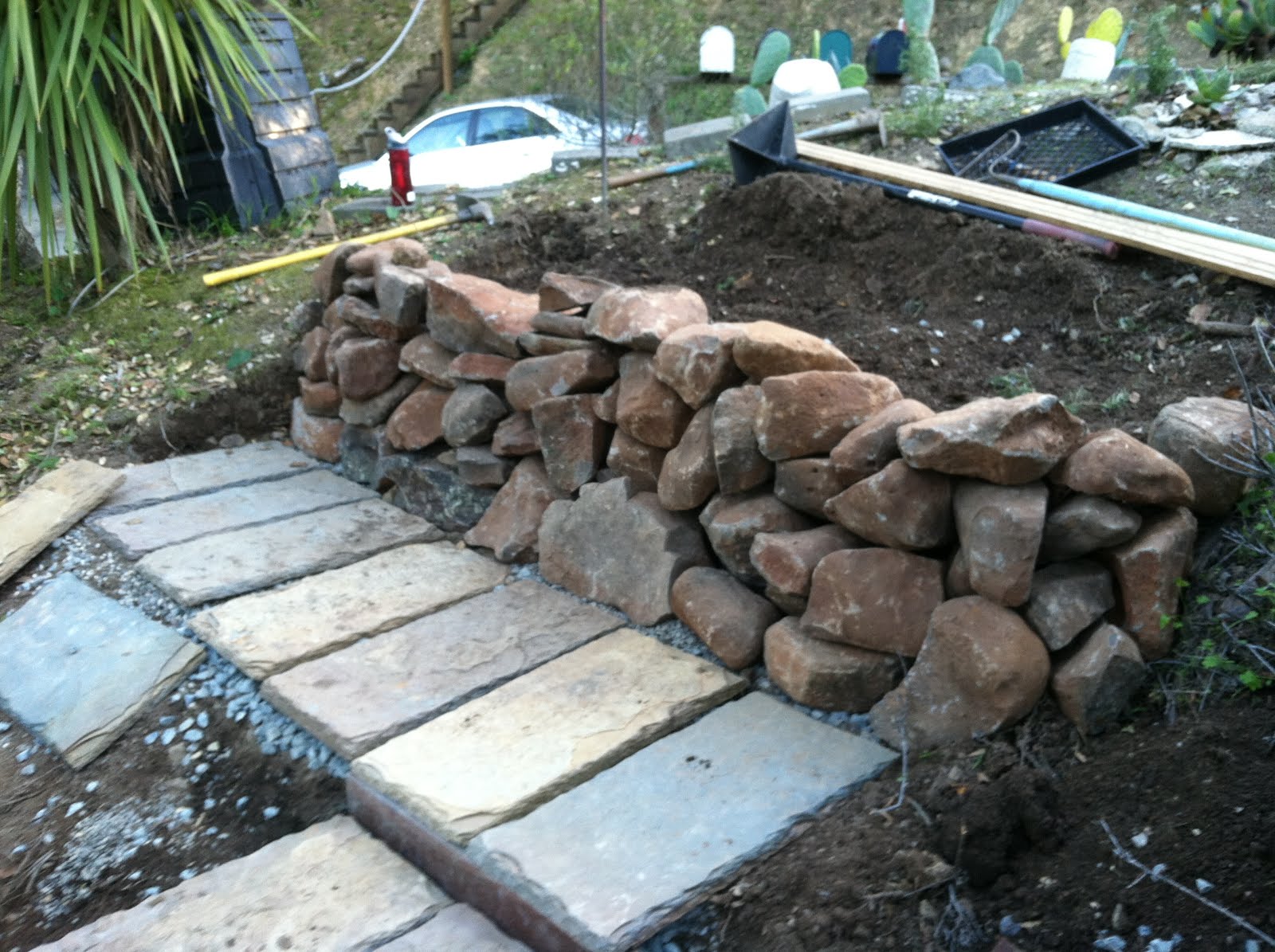
Here’s the before photo, with a couple sample rocks.

When we selected the rocks, Sonoma fieldstone, the most local and the least expensive, we learned that there are two main sizes, heads and double heads. The double heads were pretty heavy, but we didn’t need many of them. Those were for the bottom row, to create a strong, stable foundation.
—
It’s Saturday morning. We’re already done. We alloted ourselves three days and finished it in two, even with the mission creep. (Here’s to setting modest goals.) We even did some planting. Here’s a view from above. It already looks good, but will be even better as the plants grow.
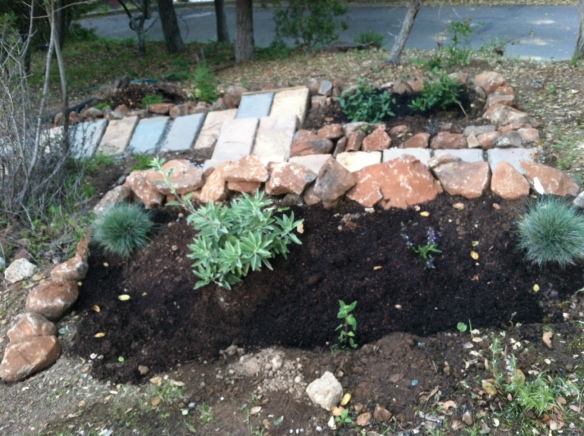
We also came up with a new startup idea: Stone Age Fitness. You pay us to be your personal trainers, and we put you to work carrying rocks down steep hillsides. Here’s Pat posing for our promo.

Here’s how we did it:
Minimal Planning, Mostly Improvisation: My plan had been to sketch out the wall and garden using my rudimentary landscape design skills. I did map out my yard in Berkeley, years ago, but it was a flat rectangle. Easy to measure. This is a curved corner lot on a steep hillside. I took a number of measurements, but never did more than the most cursory sketch. (Enough to show it to José at American Soil Products where we bought the stones, so he could help us estimate how many we needed.) More important than the sketches was reading up on some web sites and landscape design books.
What we built is called a “dry-stone retaining wall,” with no mortar to hold the stones together. The Incas built huge walls and agricultural terraces using these methods 600+ years ago. Similar walls from centuries ago have been found in Ireland, Scotland, Zimbabwe, China, and many other places. To prepare fields for planting, farmers had to remove rocks from the soil, so they were right there at hand, ready to be used for any needed structures.
Please note: This is not a how-to. We’ve never done this before. We don’t know if the rock wall will come tumbling down in a downpour, will fall over when some deer kicks it. I know more than I did a week ago — that’s as much as I can promise.
What I did do that served as a starting point was approximate where the walls and pathway would be with hoses and stakes. After walking around our worksite, we made some adjustments to these boundaries and started digging.
Fortunately, we had some heavy rains in February and the ground was soft and easy to dig. We piled the dirt on a tarp we spread out on the hillside, with an old plastic turtle sandbox on top to serve as a backstop and prevent the dirt from sliding down the hill.
The Flat Earth Society: For the rock wall and steps to be stable, we needed first to create a level surface. We cut into the hillside with picks and shovels and then, using a tamper from the Berkeley Tool Lending Library — Yay Berkeley — created a strip about three to four feet wide. Then we poured gravel on that strip and tamped it again. That was wide enough for both the foundation of the wall and the flagstone steps in front of it.
The original specs were for one rock wall about a foot deep, two feet high, and six to eight feet long, leaning into the hillside, holding a garden bed about four feet deep. Almost as important was a level pathway in front of the garden and connected to the steep steps along the side of the house. The hillside is steep enough that it’s a challenge to find any spot where you can stand with both feet at the same level. On the morning we started the job, we got two pallets delivered to our driveway with 1.5 tons of Sonoma fieldstone, 15 rustic green rectangular flagstones, each 1 foot by 2, and four bags of gravel, nowhere close to how many we needed.
We laid the flagstone steps first, because then we could stand on them while we built the wall, which went up surprisingly fast. We did have to lug a lot of rocks thirty feet or so down these steep treacherous steps from the driveway to the worksite. Below you can see Pat standing on the first three steps we laid and the cut we made into the hillside. The next shot shows the beginning of the wall.

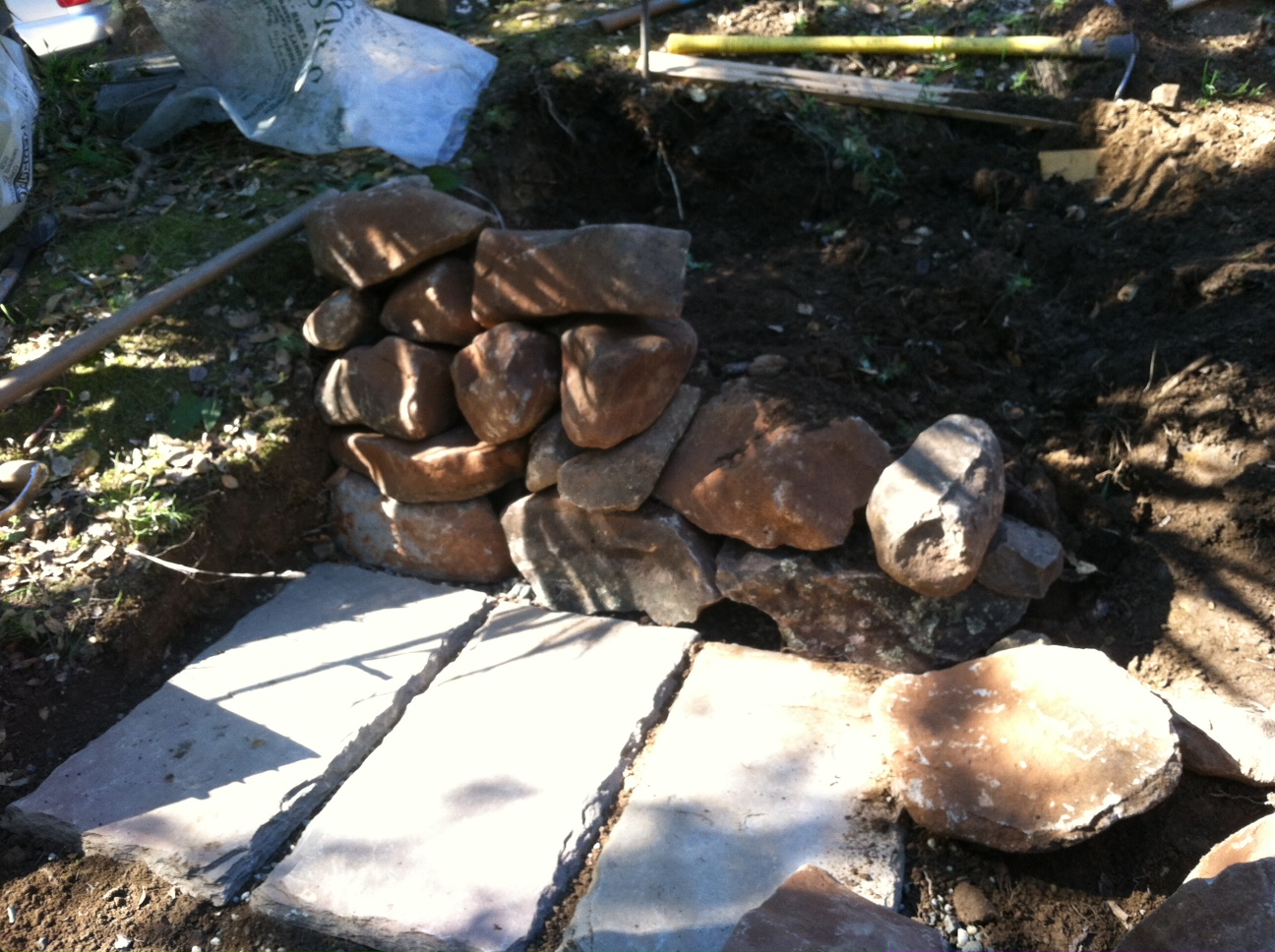
We angled the wall ever so slightly in toward the hillside, and when we reached about a foot high, we filled behind it with lots of gravel (for drainage) and some of the dirt we had dug out earlier. The stacking of the rocks was like putting together a puzzle. At first, I was looking for specific shapes, then I found it made more sense to just pick one or two rocks and then find the best spot for them on the wall. We did our best to overlap one double head on top of two heads, the way a brickmason would overlap bricks.
We completed most of the rock wall and six of the flagstone steps by midday and then we had to go out and buy some more gravel, flagstone steps, and lumber.
Overbuilding: My brother and I have both done a lot of work around our houses for years, but he’s more experienced and skilled at construction, and he suggested we get some pressure treated 4 x 4s and 2 x 8s to create frames for the stepping stones as they descended the hill. (My original thought was to do without, but he argued, correctly, that we wanted this to last through heavy rains, and we should err on the side of overbuilding. So we did.)
You can see below, just to the left of the yellow pick, the way the lumber framing allows us to move down the hills and keep the flagstones level.
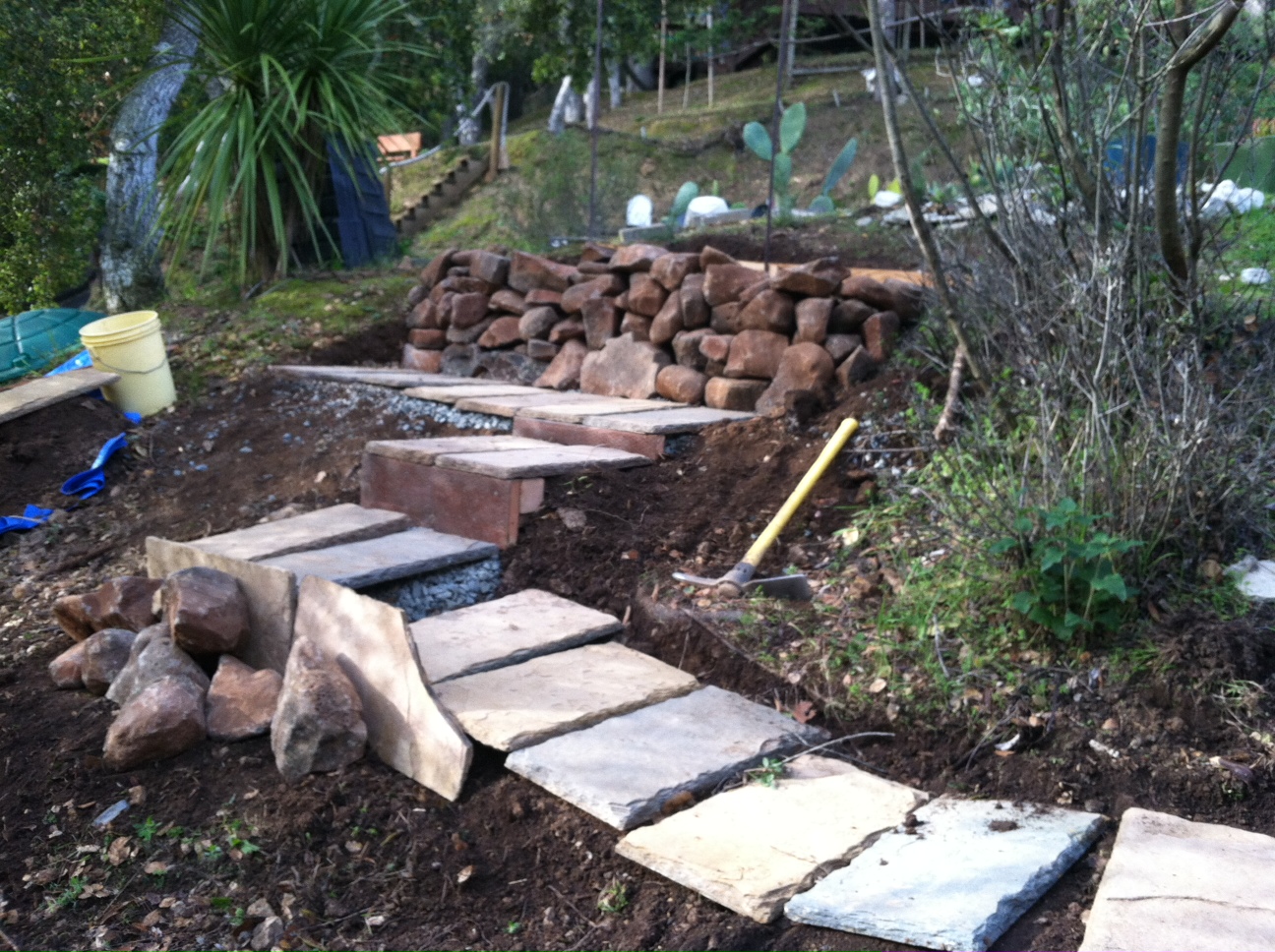
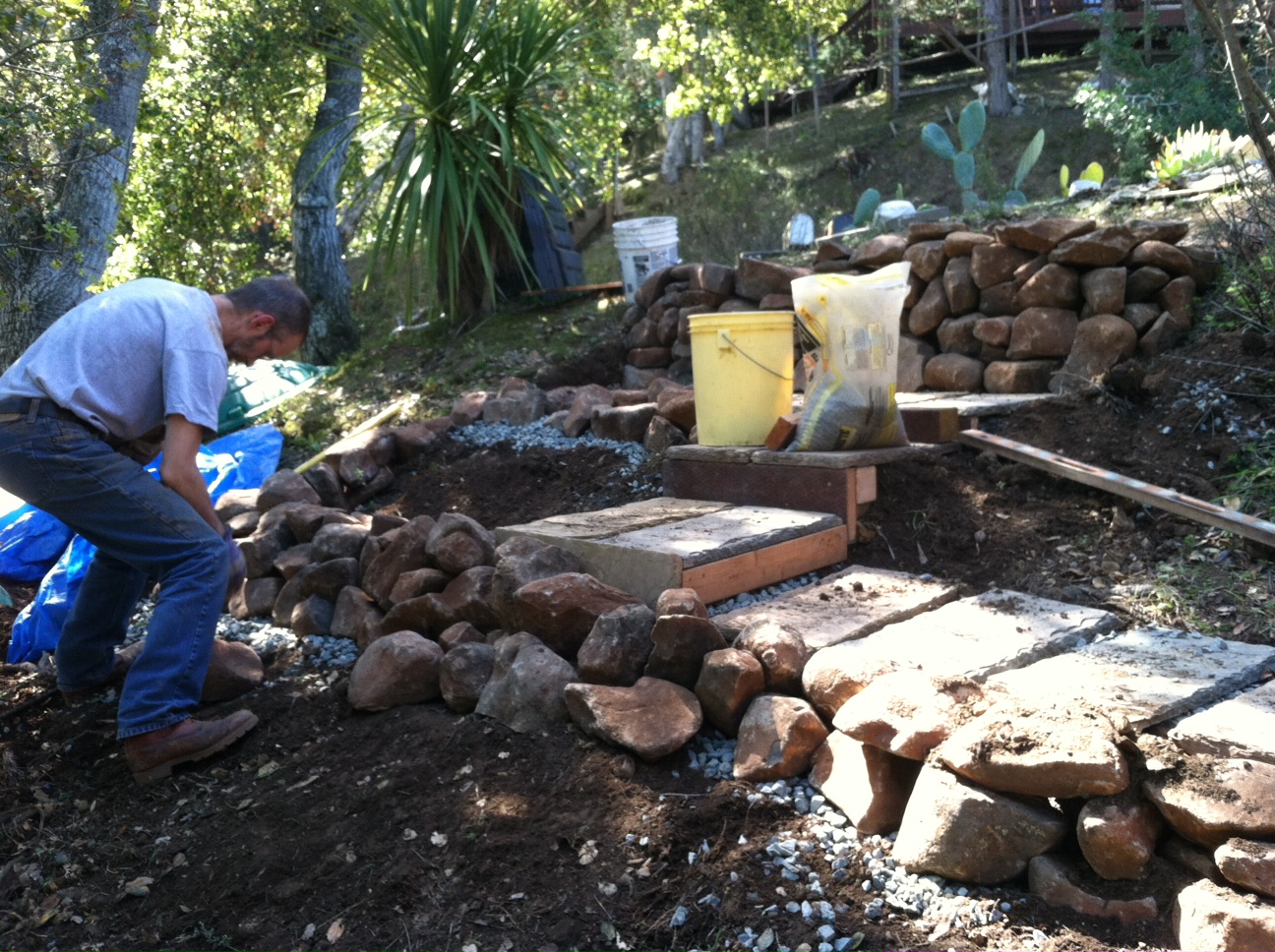
As I said, we had more rocks than we needed for one wall, so we built additional ones, to create another planting area, but mostly to give more support on the downhill side of the flagstones. So a hard rain wouldn’t wash out the gravel and dirt underneath them.
Natives, Not Vegetables: My original thought was to grow greens in the bed — chard, kale, lettuce, spinach, and so on. (Not enough sun or heat to grow tomatoes.) I knew that because of the deer, we would need to build some sort of cage to cover the bed. I did more sketches of that than the rock wall itself.
I’m a newcomer to this hillside home. My wife has lived here for more than 20 years, I’ve been here less than one. She likes the natural oak woodland look and I promised that the garden bed project would be in keeping with the natural surroundings. Certainly the rock wall seems very organic. If we dug deep enough, we’d probably find rocks just like the ones we piled into a wall.
But a cage over the bed? That could be ugly. So we decided instead for native perennials that were deer-resistant, and went down Friday afternoon to the native plant nursery at Tam Junction and picked up two coffeeberry bushes, three sages, and several grasses and groundcovers.
Here’s our planted garden from below. Pretty great, huh? While these are native plants, they may take a year or more to get fully established. Especially given the drought. But once they do, well, they’ll act as if they belong here.

(John Byrne Barry is author of Bones in the Wash: Politics is Tough. Family is Tougher.)
by John Byrne Barry | Jan 24, 2014 | Uncategorized
I’m not truly lazy. I would never garden if I were. I can buy organic produce at any number of nearby grocers and most have flowers too. But there’s something about growing them myself that I can’t shake.
But. After more than twenty years living in the flatlands of Berkeley, where I built garden beds and amended the soil with compost and manure and had sun for most of the day, I’m now living on a steep shady hillside in Mill Valley where deer nibble at everything, even allegedly deer-resistant plants like oleander. Oh, and we’re now officially in a drought.
The good news is that the winter days here have been sunny and gorgeous, with mid-afternoon temps in the high 60s and now and then hitting 70. Downright criminal for January, especially for a kid who grew up in Chicago. But I can wear shorts outside. In January.
The hillside is full of oak and bay trees and there’s a natural beauty to it that i want to keep, but I still have visions of terraced garden beds lush with vegetables and flowers. Here’s a shot of my backyard garden in Berkeley from a few summers ago.
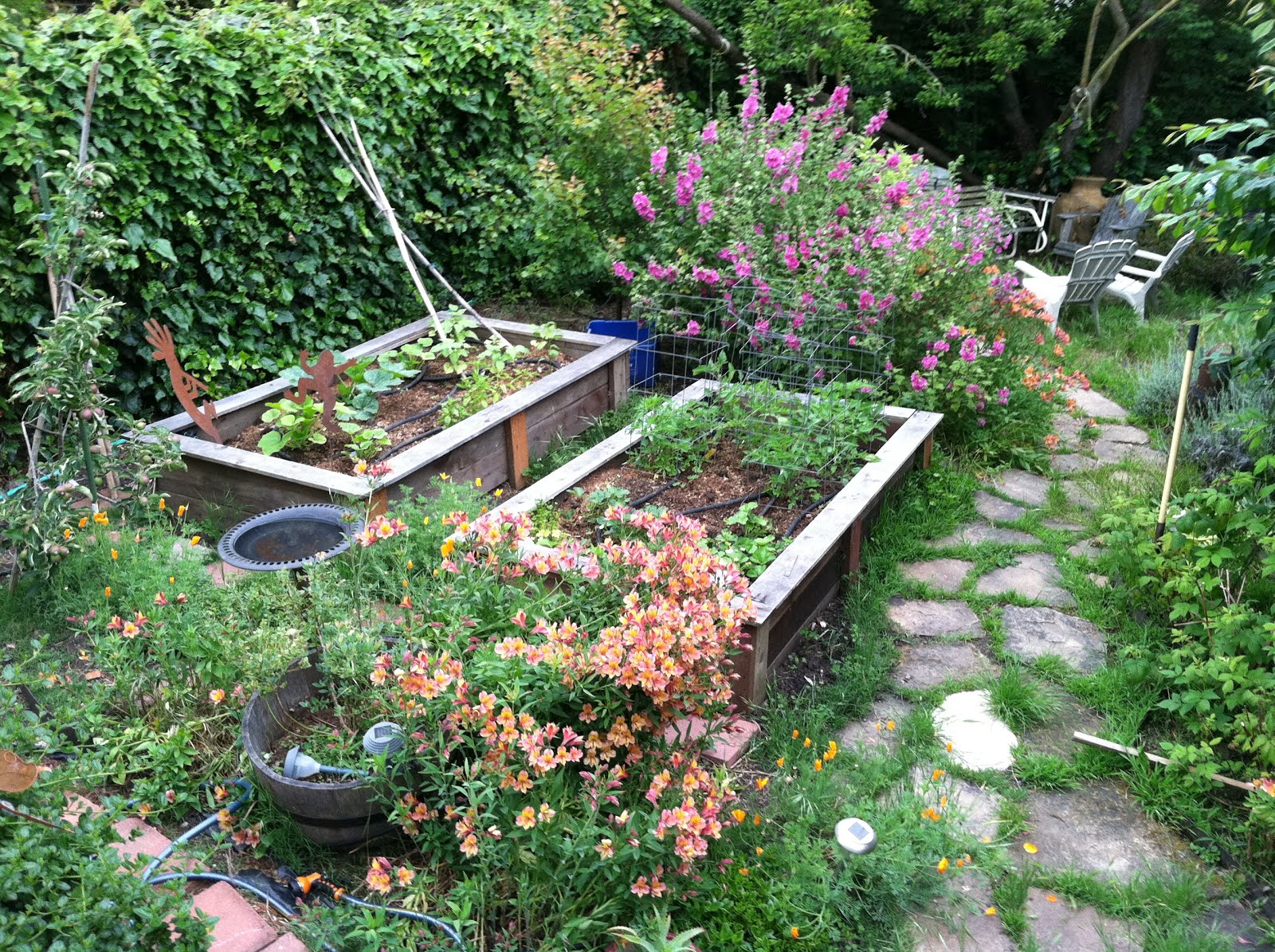
And here’s the hillside this morning.

I know the overgrown Berkeley look is not appropriate for the hills of Marin, especially during a drought. But maybe I can create a little oasis among the oak and chaparral. A neighbor down the hill has just had his backyard landscaped, and that’s given me some ideas. See those curving rock walls and the steps up the hill. It’s much more ambitious than I can even consider right now, Doesn’t stop me from dreaming.
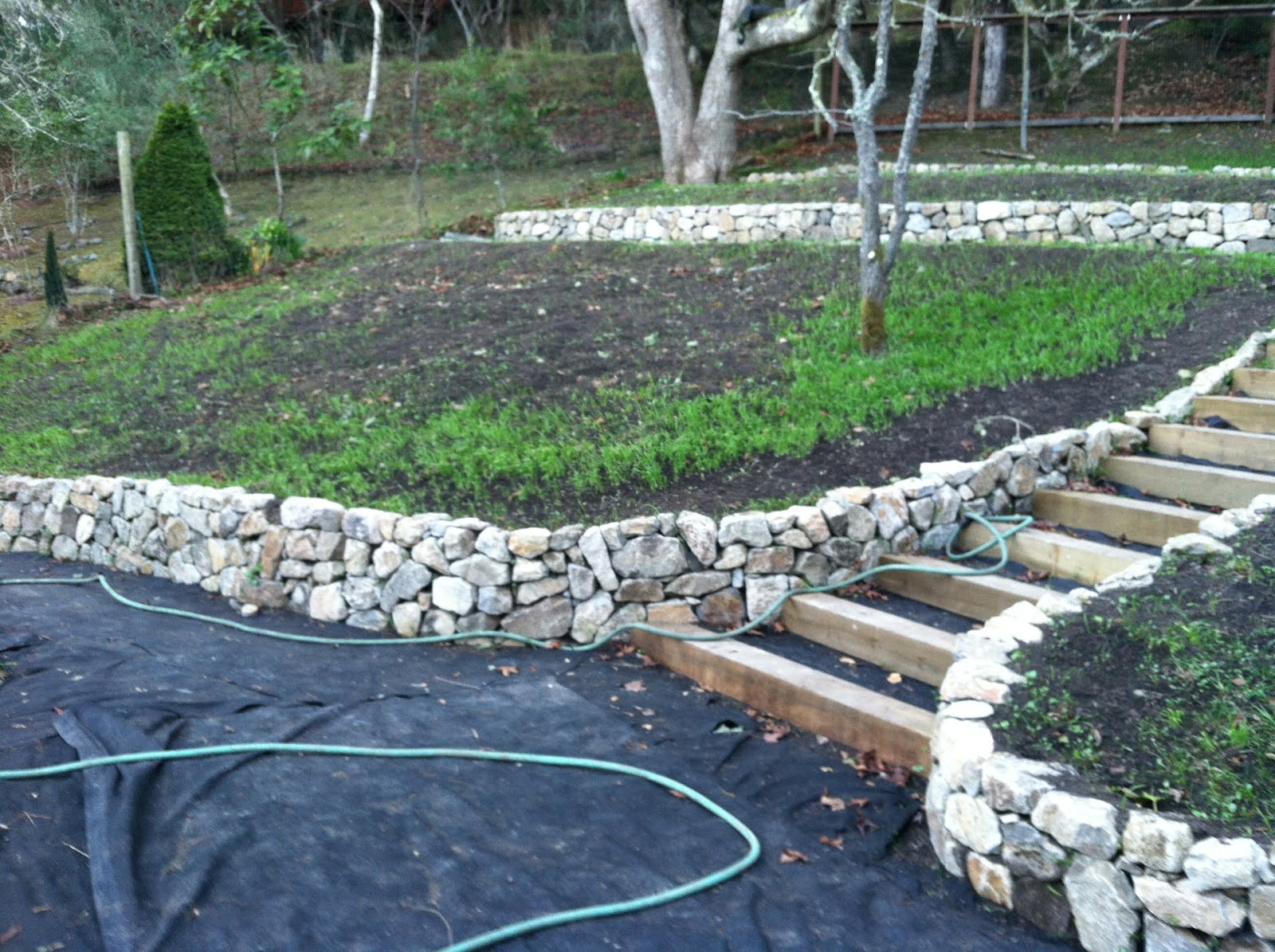
Actually I’ve been imagining rock walls ever since our visit two summers ago to the Inca Trail and Sacred Valley. Here’s one of the many Inca sites we visited, full of mortarless rock walls and irrigation channels that carried water down from the mountains.
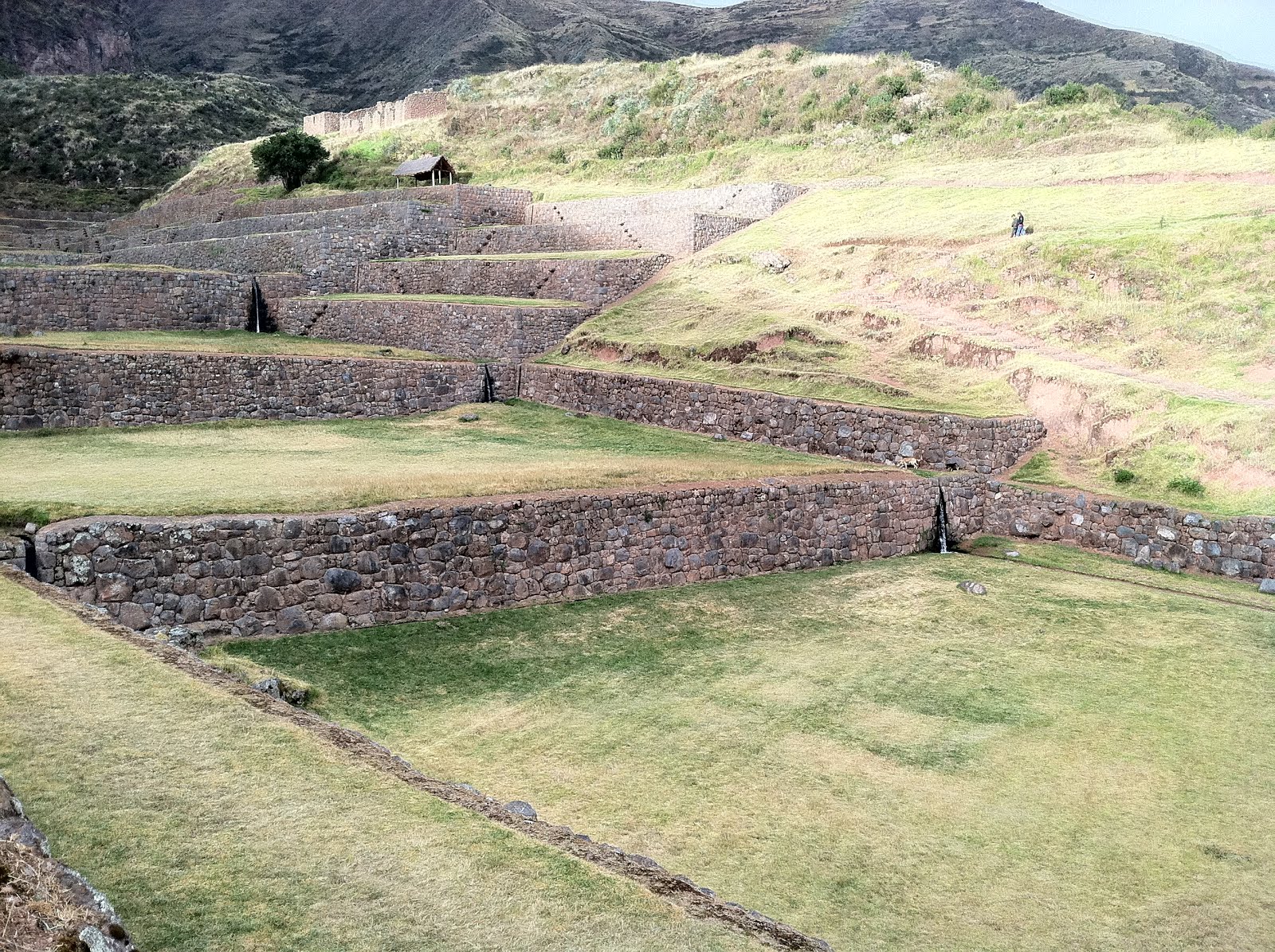
(FYI, I tried to identify that photo above, which I took, but didn’t identify. I gave up before I could, but I did find a portfolio of terraced farms, mostly from Vietnam and China. Also a few from Peru.
These visions will have to wait. (There’s lazy and there’s lazy.) I did start a garden this week, however. I started small. With a wheelbarrow, a planter box, and seeds.
I repurposed an old metal wheelbarrow, full of holes from rust, lined it with landscape cloth, filled it with potting soil and compost, and planted mesclun (summer salad mix) and arugula seeds. I know arugula grows easily from seeds. We’ll see about the lettuce mix.


The wheelbarrow is sitting on the deck outside the kitchen window. Once the seeds sprout, I’ll need to protect those baby greens from deer, which have, on occasion, brazenly trotted onto the deck. (We’ve seen evidence of their eating habits too.)
The easiest way is to string a net across the five-foot wide entrance to the deck, but that means hooking and unhooking when we go in and out through the front door. Another option, which I’ve working on, but isn’t finished, is a lightweight hoop/cage that fits over the top of the wheelbarrow. You can see what I have so far — it’s made from water sprouts pruned from my pluot tree in Berkeley, bent and held together with twine. It’s fallen apart once, but Iwith some patience, I can make it work. Once I get the “skeleton” stable, I’ll attach some a screen over the top and that should keep out the deer.

My other venture was even easier, though I had to pull out my drill. I screwed two metal brackets into the railing posts of the lower deck, high enough above the ground that even a deer on stilts can’t reach it, set an old redwood planter box on them, and planted about 15 ruby red chard seeds. Will thin later. I added a spoonful of 5-20-5 fertilizer I found under the house.

I have no drip irrigation set up here in Mill Valley so for now I will have to hand water, every day until the seeds germinate.
It’s a small step, but it’s a start. Brings to mind that Goethe quote: “Whatever you can do, or dream you can do, begin it. Boldness has genius, power, and magic in it. Begin it now.”
And so I did.
It may be a while before I built the rock terrace walls. But I think I’ll buy a new hose this weekend.
(John Byrne Barry is author of Bones in the Wash: Politics is Tough. Family is Tougher.)
by John Byrne Barry | Jan 6, 2014 | Uncategorized
Disclosure #1: There’s no gardening in this post, unless you count nature, which one could call divine gardening, if one were inclined. My intention is that this blog will be primarily about gardening, but it’s January and it feels like it’s never going to rain again in northern California, and it’s a challenge to write about gardening when I’m not doing any.
But gardening can serve as a metaphor for all sorts of things, so I think I’m covered until I get some seeds in the ground. Meanwhile, here’s a blast from the past that does include gardening — Two Top Ten Lists From the Lazy Organic Gardener.
I grew up in the Midwest and my parents were serious, albeit liberal Catholics, with maybe a bit more Calvinism in the mix than some. (I remember my Mom once saying, “You kids are having too much fun.” Now in her defense, usually one of us was crying five minutes later, so it’s not that she didn’t want us to enjoy ourselves. It’s just that pleasure was dangerous.)
Modesty was a big part of this package. How much of that came from being a Midwesterner, how much from being an Irish Catholic, and how much came from my parents is hard to sort out. But bragging was not something we did.
I’ve forgotten much more than I remember of the biblical stories and phrases we learned, but “the meek shall inherit the earth” — that stuck. It’s not that that sentiment was pounded into us as much as it was in the air and water. We were supposed to be patient, not pushy. Good things will come to those who wait.
Now for a child, those imperatives makes some sense. There’s plenty of evidence that children who can delay gratification tend to be more successful. And happier.
But the meek-shall-inherit-the-earth message is arguably about delaying gratification until you’re dead. Which is way too long.
Anyone who has actively worked to make the world a better place knows it’s not going to happen if you wait patiently. We didn’t get the Clean Air Act or the rights of women and blacks to vote or gay marriage by waiting patiently. Every advance had to be fought for. Has to be fought for.
But fighting for things. That can annoy people. Who wants to be a nag?
I bring this up because within the last month, I published Bones in the Wash — Politics is Tough, Family is Tougher, a novel set during the 2008 presidential election in New Mexico, and I left my job at the Sierra Club after 25 years.
Because I do want people to buy and read my book and I do need an income, now I have to become a shameless self-promoter.




(In case you’re wondering what these photos have to do with modesty, well, I took a long hike in Point Reyes to mark the new year and get some inspiration from the natural world — that pretty much never fails — and composed this post as I walked.)
For many years, a major chunk of my job was to promote the activities and visions of others. I was a writer, editor, and designer, and I told stories about the people on the front lines, who were fighting for clean water or endangered turtles or wilderness.
It was a behind the scenes role, and in fact, about seven years ago, I received an award called the Behind the Scenes Award for my work. I remember I gave a little speech, and talked about happiness, sharing the work of psychologist Martin Seligman, who differentiates three kinds of happiness.
The first is pleasure. We enjoyed a good meal. Had an exciting day skiing. The second is absorption, where we are so focused on what we are doing that the rest of the world recedes. Seligman uses the example of an geologist who studies crystals and starts the day looking into his microscope at a crystal and then is startled because he thinks someone has come into his lab and blocked the light when in fact the sun has gone down.
The third kind of happiness is meaning, in which what we are doing is bigger than we are. That’s why I stayed at Sierra Club for 25 years, because of the meaning.
(I don’t recall if I included my favorite Seligman anecdote, which he uses to illustrate optimism, but I can’t resist including it now. A child and her mother are driving, and the daughter says, “Mom, where are all the assholes today?” Whereupon her mother answers, “Oh, they’re only out on the road when your father drives.”)
But meaning, I was talking about meaning. That was how I was able to push past my modesty and promote various causes and people. It wasn’t about me.
Now it is
In my farewell note to my work colleagues, I said a lot of nice things about people I worked with, and I ended with a little blurb about my book and my modesty.
If I were a shameless self-promoter, I would tell you all about my recently published novel, Bones in the Wash, a political thriller + family soap + murder mystery set during the 2008 presidential campaign in New Mexico. And available as a trade paperback and e-book. But I was born and bred in the Midwest, so it’s hard to break out of that modesty-is-best mentality.
Oh, did I mention you can read the first three chapters at bonesinthewash.com?

That’s one way I’ve managed this self-promotion. By keeping it light. By mocking myself a bit.
Oh, did I also say that I’m a skilled and experienced writer + editor + designer + strategist, occasionally brilliant and always reliable?
I welcome your ideas on self-promotion.
 I met Arielle Friedtanzer last November when she attended my book launch in Tam Valley (“Why I Wrote an Assisted Suicide Family Thriller”), one of the more than 200 events comprising Reimagine End of Life, a San Francisco Bay Area wide exploration of big issues about life and death.
I met Arielle Friedtanzer last November when she attended my book launch in Tam Valley (“Why I Wrote an Assisted Suicide Family Thriller”), one of the more than 200 events comprising Reimagine End of Life, a San Francisco Bay Area wide exploration of big issues about life and death. 




 I was on her left, about three or four people away, walking sideways for much of the march, holding hands with Jane, my other buddy, a few feet ahead of me on my right, and a man whose name I never learned a few feet behind me on my left. Sometimes both my arms were being pulled, in opposite directions. We didn’t always stay in formation, but the wedge worked the way it was supposed to. I had never given much thought to how to manage a march. It was harder than I expected, especially with crowds in the tens of thousands. We heard estimates ranging from 60,000 to 100,000. I was in no position to assess the size of the crowd, other than it was larger than organizers expected. And everyone was peaceful.
I was on her left, about three or four people away, walking sideways for much of the march, holding hands with Jane, my other buddy, a few feet ahead of me on my right, and a man whose name I never learned a few feet behind me on my left. Sometimes both my arms were being pulled, in opposite directions. We didn’t always stay in formation, but the wedge worked the way it was supposed to. I had never given much thought to how to manage a march. It was harder than I expected, especially with crowds in the tens of thousands. We heard estimates ranging from 60,000 to 100,000. I was in no position to assess the size of the crowd, other than it was larger than organizers expected. And everyone was peaceful.

Recent Comments